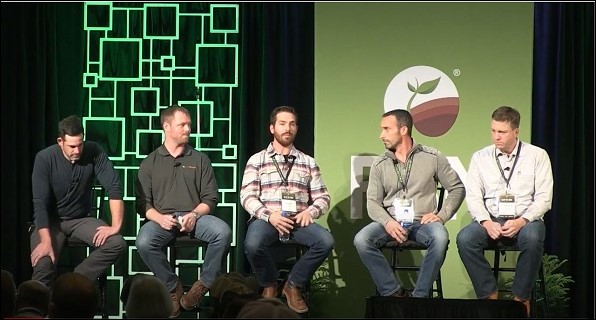- Published On: February 20, 2020
- Author: Steve Sinkula
The biggest benefit of marketing organic crops are the price premiums. Over the last decade we’ve seen premiums almost double conventional crops, with organic corn averaging over $9.50 a bushel and soybeans more than $20 per bushel.
While we can’t predict what prices will do in the future, there’s continued underlying growth in the demand for organic foods, and not enough acres in the U.S. to support it, which indicates a premium will persist.
But aside from the opportunity to generate more revenue per acre, marketing organics has other potential benefits. Organic prices don’t move as frequently as conventional prices, where an additional nickel or dime can have a big impact on profitability, so farmers don’t have to worry about the market on a day-to-day basis like conventional farmers.
-
Source: USDA ERS
-
Source: USDA ERS
There’s also the ability to lock in prices before you start growing your crop – but in a way that is a bit different than conventional. Many organic contracts are acreage contracts, so if your yields aren’t as high as you expected, you don’t have the risk of being unable to fulfill a contract based on volume. Buyers are also pretty understanding of the risk organic farmers take, so it is often common to contract organic crops before the crop is planted.
Additionally, some organic originators will even pick up your crop on-farm. Due to the high demand for organics and a relatively fragmented landscape, organic grains often have to travel a far distance to reach their destination, so picking the crop up along the way is not a barrier for buyers.
But in order to reap these benefits and generate strong profits, growers need to be aware of the differences between marketing organic and conventional crops, and have a strategy to reduce risk as much as possible.
1. Create a marketing plan
One important difference between marketing conventional and organic crops is that there is no futures market in organics — everything is cash marketed, either as forward or spot contracts.
That means in order to reduce your risk and ensure a buyer for your crop, you need to look at your crop rotation and create a marketing plan for those crops. Since organic requires a more diversified rotation than just corn and soybeans, you need to ensure there are markets for the crops you plan on growing. We recommend you start understanding your local market during the transition period.
When you’re entering into your first season as an organic farmer, we advise having your marketing conversations the fall before you even plant that crop. In some cases you’ll want to have a contract in place first, especially if it’s not a typical crop like organic feed-grade corn or soybeans. Organic yellow field peas is an example where you need a contract before planting, especially since buyers can have specific varieties they want to buy.
2. Evaluate potential buyers
Part of creating a solid marketing plan is researching potential buyers, so even if you don’t have a contract in place, you have a good idea of where you can market your crop. Never expect that a market is going to be there.
Finding those buyers can be easier said than done. The organic marketplace is pretty opaque, so if you don’t have a partner like AgriSecure helping you, plan on spending a lot of time talking to other organic farmers and calling around with others engaged in organics to discover where those markets may be. Often they will not be the traditional companies you’d deliver conventional grain to in the past.
When you do find potential buyers, you need to evaluate the following about them:
- What kind of contracts do they offer? What risk do those carry?
- What’s their delivery process?
- How do they handle their paperwork — are they timely in providing accurate paperwork to you?
- Do they seem to take more or less deductions than others in the marketplace?
- How quickly do they pay?
You’ll also want to do your homework in making sure it’s a reputable buyer who is going to pay you. We emphasize trying to work with larger established groups, like Scoular or Pipeline Foods. If you haven’t heard of the buyer before, that should raise your eyebrows. Tap into your network and get references and recommendations from others first.
3. Reduce your risk
In addition to working with a reputable buyer, you need to understand your contracts to further reduce risk. For instance, if you’re in a bushels contract, where do you want to be marketing at certain points in the year? Do you want to have a certain percentage of your anticipated production sold by a certain timeframe?
Are there going to be penalties if you can’t meet the bushel contract you signed up for? Some buyers may be more lenient than others if you come up short in the amount you’re contracted, so it’s important to know that ahead of time.
Locking in prices vs. waiting for something higher is another risk to evaluate. If you can lock in corn at $8.50, is it worth the risk of trying to get another quarter or $.50 out of that vs. having a known profit locked in?
Some organic buyers will offer contracts 2 crop years out, and when they do that, the price structure is typically lower than where the crop is trading today. You need to consider the economic benefits of having that known price vs. waiting to see what the market gets you 12 months from now.
Quality management is also key in reducing risk. You also need to consider quality with storage. If your grain goes out of condition, you’ve lost your organic premium and you’ll have to sell it as conventional.
Understanding risk around quality metrics is very important as well. For example, wheat grown in higher humidity environments, such as the Midwest, can often have issues with disease pressure. If you forward contract for food-grade quality, but rust or aflatoxins leave you with feed grade wheat you might find yourself in a tough spot. Knowing your risks and downside scenarios before planting food-grade is recommended.
Finally, don’t forget about crop insurance. For example, in the Midwest some small grains and pulse crops are not eligible for standard multi-peril, so you need to consider the risk you’re taking on if you grow that crop vs. the premiums you earn. Working with someone who really understands organic crop insurance well, such as FBN, can really make a difference in reducing risk.
4. Think through logistics
The logistics of storage and delivery are also key aspects of developing a good marketing plan and protecting your profitability.
You first need to evaluate whether you have the resources to deliver or store the crops, especially if you grow more than expected. If you have extra, will you have a separate bin that can be cleaned for dedicated organic storage and added to your Organic System Plan (OSP)?
You also need to think through how these factors impact your bottom line. With organic premiums, you may be able to haul it further than you normally would consider with a conventional crop, and still make a really good profit. On the other hand, you don’t want to realize that you picked up an additional quarter on price, but are losing $0.45 for every bushel because it’s a further delivery location. Always pencil out the economics when evaluating the logistics of your marketing.
5. Get support
Marketing organic crops is not a simple task and can be a huge undertaking. Unfortunately, there’s not a lot of publicly available resources that track price history or list originators, so we recommend finding the right experts and support to help navigate the landscape.
If you don’t understand what your options are or how to market your crops, AgriSecure can help. We can help you understand the market dynamics and identify the best contract terms to make sure you’re reaping the highest profits possible. Contact us today to learn how to start selling your organic crops with success.
By Steve Sinkula, AgriSecure Founder and CEO, and J.P. Rhea, AgriSecure Founder and Owner of Rhea Brothers GP
Related Articles
-
Imports Have an Impact on Organic Crop Prices: Here’s Why
Organic soybean prices are skyrocketing. The Jacobsen reported that prices were up to $32 per bushel in the Midwest in May 2021. What’s behind this impact on organic crop prices? And why aren’t organic corn premiums keeping up? In short: it’s all about supply and demand, especially imports, says David Becker. David is an analyst […]
-
New Options Offer Farm Loans for Organic Transition
If securing farm loans for organic transition feels daunting, we have some good news. It’s not as hard as it used to be. In fact, there’s a number of new options that could provide a solution for you and your operation. Traditional lenders, farmland investors, non-profits, and even big food companies are starting to create […]
-
Organic Farming Loans Support Growers during Transition
Ask a farmer what’s keeping them from transitioning to organic row crops, and you may be surprised to hear a common answer. Finances. It’s often a struggle to find organic farming loans tailored to their needs. Yes, organics offer excellent premiums and can bring long-term profitability. But first you have to get through the 36-month […]
-
Organic Breakevens: What to Know and How to Calculate
If you’re thinking about organics, you’ve probably debated whether it’s going to pay off — literally. Yes, the price premiums are good, but you’ve heard your yields will take a hit. How can you predict profitability? The answer: calculating your organic breakevens. What are an organic breakevens? Simply put, it’s a way to calculate what […]
-
Know Your Numbers to Push Crop Profitability
Yield is often the top priority in farming. The truth, though, is that the highest yields will not necessarily result in the highest ROI. And this is especially the case for organic production. We know good execution results in the best yields, but the best way to maximize your crop profitability is to know your […]
-
6 Ways to Protect Organic Profits in Uncertain Times
Economic uncertainty hits all sectors of the agriculture industry, including organics. The good news? It’s possible to safeguard your organic profits. For a start, it’s even more important for organic farmers to focus on executing their operations really well. The better the execution, the better you can weather the market conditions and remain profitable. Here […]
-
5 Steps for Financing the Transition to Organics
Profits. They’re one of the primary reasons farmers decide to move into organic production. Financing the transition to organics, though, can be one of your biggest hurdles. That’s why the support of a banker or ag lender can be a lifeline for farmers looking to get into organics. The right backing helps you build an […]
-
4 Keys to a Strong Organic Fertilizer Strategy
Questions about an organic fertilizer strategy are common in organic farming. How do I provide enough nutrients? In particular, nitrogen. How do I manage my crop and soil without using synthetic fertilizers? Fertilizer can come from a variety of organic sources, including animal waste, decomposing plants, and nitrogen-fixing crops like soybeans and clover. So it’s […]
-
Consider Organic Farming? Yes.
With so much economic uncertainty caused by the COVID-19 pandemic, you may be wondering: Is now the right time to transition into organic crop production? Is this the right time to increase the number of organic acres you’re already farming? My answer, yes. Current market conditions, falling commodity prices for conventional crops and somewhat lower […]
-
80 Million Millennials Can’t Be Wrong: Farmer Panel
80 million millennials are a part of the driving force behind the rapid growth of organic food demand. So why aren’t more farmers transitioning into a system that sees premiums of 2x over conventional and profitable margins? In a panel that took place at FBN’s Farmer2Farmer V event, AgriSecure co-founder and organic farmer Bryce Irlbeck […]
Get in the know
Our newsletter, it’s a quick read. You’ll get industry news plus all the latest organic insights. Who doesn’t want that?












